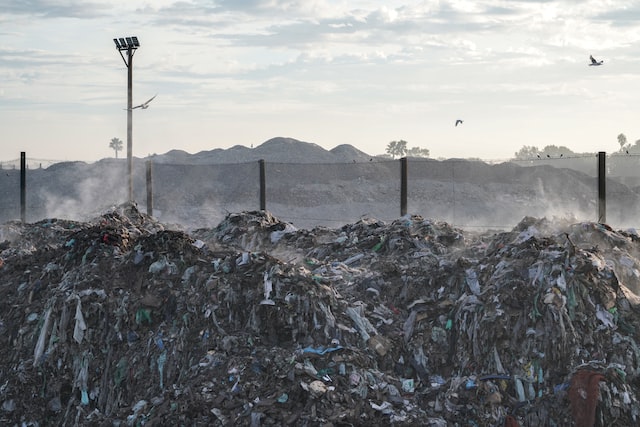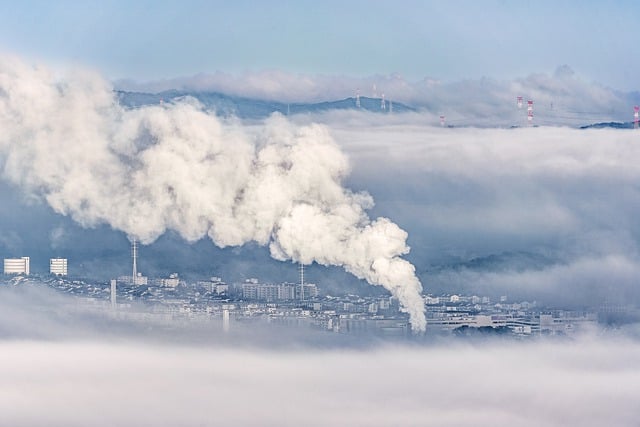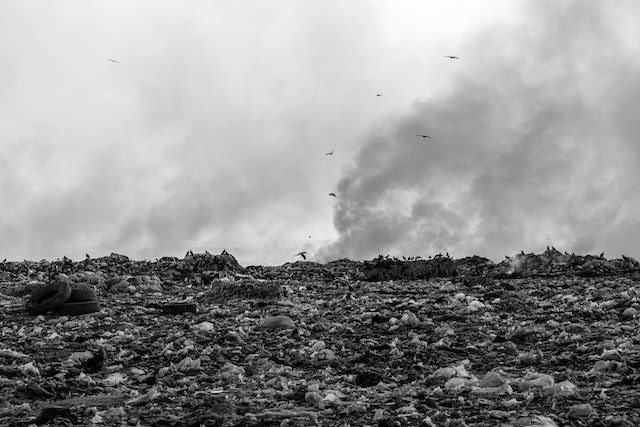Landfill and incineration are two methods of waste disposal that have both their benefits and drawbacks. Landfills require large amounts of space, can damage the environment, and take a long time to decompose materials. Incineration is a more efficient process since it requires fewer resources, produces less pollution, and reduces the volume of waste by up to 90%. Ultimately, your choice between landfill and incineration depends on the type of material you need to dispose of as well as other factors such as local regulations.
Landfill
(Photo by Katie Rodriguez on Unsplash )

Landfills are sites specifically designed for the disposal of waste materials. They are usually large areas of land that are carefully chosen to minimize environmental impact and risks to public health.
When waste is collected from households, businesses, and other sources, it is transported to a landfill site. At the landfill, the waste is compacted and buried under layers of soil, which helps to reduce odors and prevent the spread of disease. Landfills are carefully designed to prevent contamination of the surrounding soil and water, and they are lined with layers of impermeable materials to prevent the leakage of toxic substances.
Landfills are usually managed by local governments or private waste management companies. They are typically operated according to strict regulations and guidelines that are designed to protect public health and the environment. These regulations include requirements for the proper handling and storage of hazardous waste, as well as for the monitoring of groundwater and surface water quality.
Despite their careful design and operation, landfills can still pose a risk to public health and the environment. They can release harmful gases, such as methane and carbon dioxide, which contribute to global warming. They can also contaminate groundwater and surface water if they are not properly managed. As a result, there is growing interest in alternative waste disposal methods, such as recycling and composting, that are more sustainable and environmentally friendly.
Incineration
(Image by Kanenori from Pixabay )

Incineration is the process of burning waste material at very high temperatures so that it is reduced to ash. This process can be used to generate electricity, but it is more commonly used to simply get rid of waste material. Landfill is the process of burying waste material in the ground. This process can be used to create energy, but it is more commonly used to simply get rid of waste material.
What is the difference between landfill and incineration?
Landfills are sites where waste is buried under the ground. Incineration is the process of burning waste.
The main difference between landfill and incineration is that landfill is a method of disposing of wastes by burying them under the ground while incineration is a method of disposing of wastes by burning them. Landfill is generally less expensive than incineration and can be used for a variety of waste materials, including biodegradable waste, paper, cardboard, and metal cans. However, incineration reduces the volume of waste by about 90 percent and produces energy that can be used to generate electricity.
Pros and Cons of Landfills
Pros of Landfills:
- Efficient disposal: Landfills are a convenient and cost-effective way to dispose of large amounts of waste. They can handle a wide range of materials, including hazardous waste, which may not be suitable for other types of disposal.
- Job creation: The operation and maintenance of landfills provide employment opportunities for many people, including engineers, waste management professionals, and construction workers.
- Land reclamation: After a landfill site is closed, it can be reclaimed and used for other purposes, such as parkland or commercial development.
- Energy generation: Methane gas produced by decomposing waste in landfills can be captured and used to generate electricity.
Cons of Landfills:
- Environmental impact: Landfills can have a significant impact on the environment, including contamination of soil, groundwater, and surface water. They also contribute to greenhouse gas emissions, which can contribute to climate change.
- Health risks: Landfills can be a source of air pollution, including harmful gases and unpleasant odors. They can also attract pests, such as rats and mosquitoes, which can carry disease.
- Limited capacity: As landfill space becomes scarce, waste disposal becomes increasingly challenging and expensive. This can result in the transportation of waste over long distances, which increases costs and carbon emissions.
- NIMBYism: Many communities oppose the construction of new landfills near their homes, which can lead to legal battles and delays in waste management projects.
While landfills may provide an efficient and cost-effective way to dispose of waste, they also have significant environmental and health impacts. As a result, it is important to consider alternative waste management strategies, such as recycling and composting, to reduce our reliance on landfills.
Pros and Cons of Incineration
Pros of Incineration:
- Volume reduction: Incineration can reduce the volume of waste by up to 90%, which reduces the amount of space needed for waste disposal.
- Energy generation: Incineration can produce heat and electricity, which can be used to power homes and businesses.
- Reduced greenhouse gas emissions: Incineration can reduce greenhouse gas emissions compared to landfilling, as it releases fewer methane emissions.
- Hazardous waste management: Incineration is an effective way to manage hazardous waste, as it can destroy harmful chemicals and pathogens.
Cons of Incineration:
- Air pollution: Incineration can release harmful pollutants into the air, such as dioxins, furans, and mercury, which can have negative health impacts on nearby communities.
- Cost: Incineration can be expensive to operate, with high capital and operating costs, which can result in higher waste disposal fees for consumers.
- Public perception: Many people view incineration as an unsustainable and harmful waste management method, which can result in community opposition to new incineration projects.
- Waste reduction: While incineration can reduce the volume of waste, it does not address the underlying issue of overconsumption and waste generation.
While incineration may provide some benefits, it also has significant environmental and health impacts. As a result, it is important to consider alternative waste management strategies, such as recycling and composting, to reduce our reliance on incineration.
Which is better for the environment?
When it comes to deciding which is better for the environment – landfill or incineration – there are a few things to consider. Landfill sites can release methane, a potent greenhouse gas, into the atmosphere. On the other hand, incineration facilities emit carbon dioxide and other pollutants into the air.
So, which is the lesser of two evils? It depends on a number of factors, including the type of waste being disposed of and the technology used at the disposal site. In general, however, landfill is considered to be more harmful to the environment than incineration.
What are the costs of each method?
The costs of each method can vary depending on the size and location of the landfill or incineration facility. For example, a small rural landfill may cost less to operate than a large urban incineration plant. Landfills can also be more expensive to build and maintain than incinerators.
What is the difference between incineration and burning?
Whereas burning refers to the combustion of organic matter in the presence of oxygen to produce heat, incineration is a process that involves the combustion of organic matter in the presence of oxygen to produce heat and/or steam. The main difference between the two processes is that incineration takes place in a controlled environment, such as an incinerator, whereas burning can take place in any environment.
Incineration is considered a more efficient way to dispose of waste because it reduces the volume of waste by up to 90% and produces less emissions than burning.
What are the methods of incineration?
Incineration is the process of burning waste material at extremely high temperatures in order to reduce its volume. This method of waste disposal is controversial, as it can release harmful pollutants into the atmosphere if not properly regulated.
There are two primary types of incineration: mass burn and refuse-derived fuel (RDF). Mass burn incineration involves burning waste in a large chamber with little to no pretreatment of the material beforehand. RDF incineration involves shredding and drying the waste before it is burned, which results in a cleaner burning process and less environmental pollution.
The benefits of incineration include reducing the volume of waste material by up to 90%, which can save space in landfills. It can also generate electricity through the use of steam turbines. The drawbacks of incineration include the release of pollutants such as carbon dioxide, sulfur dioxide, nitrogen oxides, and heavy metals into the atmosphere, as well as the high cost of building and operating an incinerator facility.
Featured Image By – Photo by Collab Media on Unsplash








